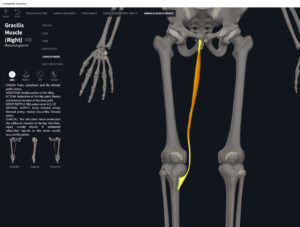Anatomy & Physiology: Muscles—Gracilis.
Structure.
- Origin: anterior aspect of lower body of pubis.
- Insertion: proximal medial surface of the tibia (pes anserine).
Function.
- Concentric action: accelerates hip adduction, flexion, and internal/medial rotation; assists in tibial internal rotation.
- Reverse mover action: anterior til pelvis; ipsilateral elevation of pelvis; ipsilateral rotation of pelvis; thigh flexion, lateral rotation.
- Eccentric action: decelerates hip abduction, extension, and external rotation.
- Isometric action: stabilization of lumbo-pelvic hip complex and knee.
- Innervation: obturator nerve.
- Arterial supply: deep femoral artery, obturator artery.
Clinical Significance.
More.
- https://www.anatomynext.com/gracilis/
- https://www.youtube.com/watch?v=FrmkNqk8Fmo
- https://www.youtube.com/watch?v=NDsPj1qATiU&vl=en
- https://www.youtube.com/watch?v=6yObWqnDDa0
- https://www.youtube.com/watch?v=265T4ywr6uY
References
Biel, A. (2015). Trail guide to the body: A hands-on guide to locating muscles, bones and more.
Clark, M., Lucett, S., Sutton, B. G., & National Academy of Sports Medicine. (2014). NASM essentials of corrective exercise training. Burlington, MA: Jones & Bartlett Learning.
Jenkins, G., & Tortora, G. J. (2012). Anatomy and Physiology: From Science to Life, 3rd Edition International Stu. John Wiley & Sons.
Muscolino, J. E. (2017). The muscular system manual: The skeletal muscles of the human body.



